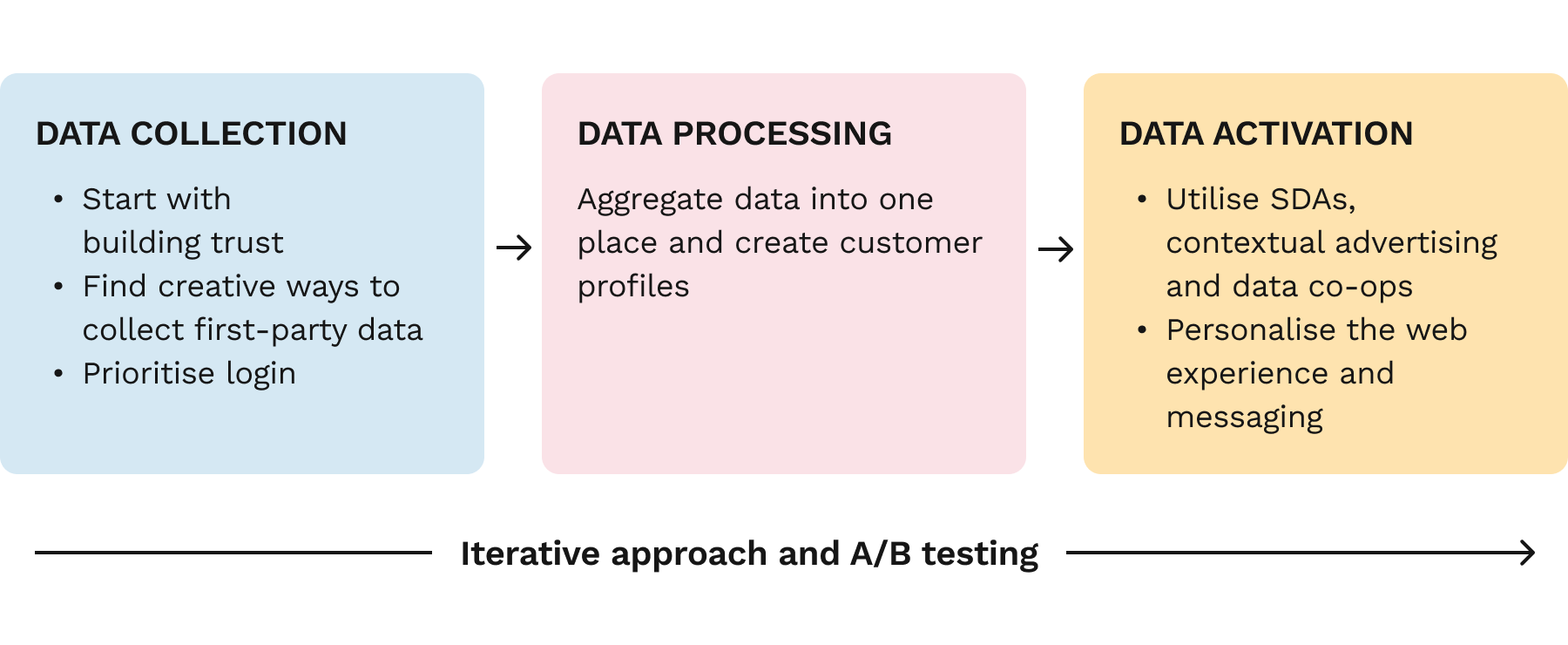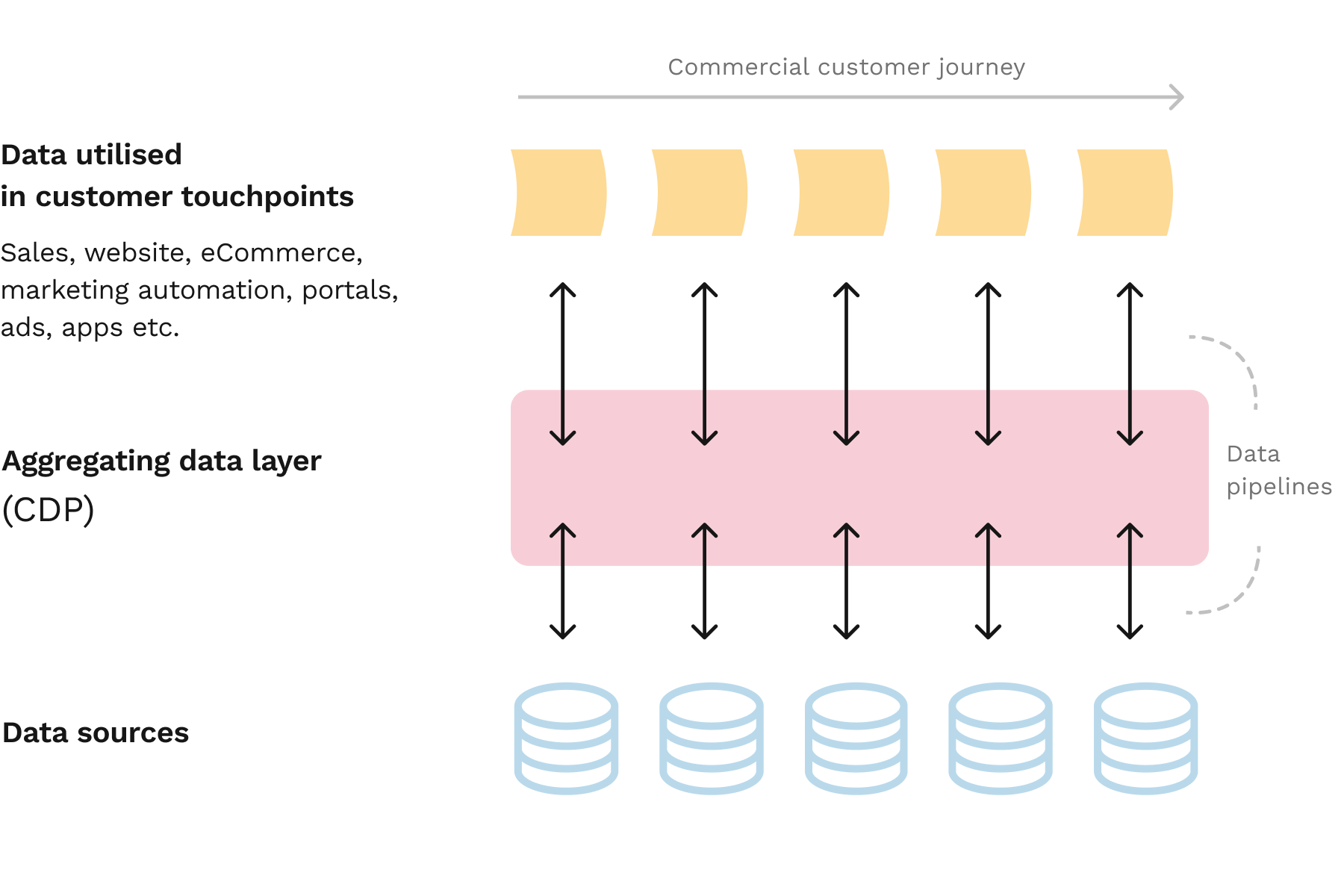Checklist for cookieless marketing
Get a head start on the cookieless future with this downloadable checklist!
The world of digital sales is about to change with the end of third-party cookies. The change forces marketers to rethink how they can reach the right audience digitally. While going cookieless might be a significant challenge, there remain vast opportunities for those who can collect, process and leverage first-party data creatively and efficiently. In our "Going cookieless" series, we explore each in depth.
Our previous blog post explores different possibilities of collecting zero-party and first-party data. Collecting data is merely the beginning of succeeding in the cookieless future of digital sales. For companies collecting data, data creation, analytics and processing are vital competencies to focus on. This blog post introduces you to some of the best practices for processing first-party data.

Three ways to data creation and analytics
In the fast-paced world of online sales and marketing, it's essential to have a robust and reliable system for web and data analytics. However, there are various approaches that businesses can take to collect and process user data. Namely, the anonymous approach, server-side tracking and the do-it-yourself approach, which each have their unique advantages.
The first approach is 100%(-ish) anonymous, which eliminates the need for cookie banners or GDPR consent. It allows you to track your visitors without collecting any personally identifiable information, such as IP addresses or user IDs. This approach is enabled by tools such as Plausible, which uses alternative methods of tracking website activity, such as log file analysis, to generate web analytics data.
The second option is server-side tracking, which allows you to filter your data before sharing it with third-party tools like Google Analytics. Server-side tracking is a method of collecting web analytics data by sending data directly from a website's server to a tracking tool rather than relying on client-side scripts or cookies.
Lastly, there’s a do-it-yourself route, which involves combining out-of-the-box solutions with customisations and advanced analytics tools to collect clean and structured behavioural data. For example, Snowplow – a web analytics tool for complex use cases – allows this approach.
Aggregate data into one place and create customer profiles
It’s more than common that important data is found in silos within your organisation, held tight by different gatekeepers. To be able to activate and leverage data well, companies ought to make a solid plan to collect and surface relevant customer data.
Data that should be aggregated to create a holistic understanding of your customers:
- Behavioral data: Make sure your track important behaviour on your websites and apps, and track both macro and micro conversions.
- Transactional data: Don’t let other companies in charge of transactions, such as Klarna, own your transactional data.
- CRM data: Make sure your sales team keep customer data up to date.
- Call centre data: Organise and surface data from your customer service.
- NPS and other surveys: Make survey data available to the organisation in order to gain insights into the satisfaction or dissatisfaction of your customers.
In order to create a holistic understanding of your customers using the data you’ve collected, it’s wise to aggregate data into one place. Customer Data Platforms allow you to do this.
A Customer Data Platform (CDP) is a packaged software offering a persistent and unified customer database which is accessible to other systems. CDPs store data that is gathered from various first-party sources such as web and mobile, CRM, other offline data sources, transactions, and other behavioural data – all in one place. They enable marketing with real-time personalisation and targeted messaging in multiple channels as well as the unification of customer profiles.

There are seven steps to getting started with a CDP project:
- Describe use cases for data usage and involve all relevant stakeholders
- Prioritise use cases based on the business value which can be achieved
- Identify existing first-party customer data sources
- Audit the existing data: do you have data in quantities and in the quality needed for the use cases?
- Plan data quantity and quality improvement actions based on prioritised use cases
- Create a roadmap for the CDP development process - which actions have the best potential ROI?
- Get started!
Once you’ve collected and processed data well, it’s time to start thinking about leveraging and activating the data you’ve collected. The next post in our blog series on the cookieless future of digital sales gives you tangible ideas into the opportunities that arise with the change in the industry.
Read other parts of the series:
The digital sales and marketing landscape is set to face a major challenge with the disappearance of third-party cookies. At Columbia Road, we see this as an opportunity for those who are ready to adapt and embrace change.
As a premium partner in digital commerce, we specialise in building seamless digital solutions and running concrete growth activities that help businesses sell better. Our cross-functional teams work hands-on and take ownership of your business goals. Data is in our DNA, and we always deliver results – even in the cookieless future of digital sales.
The Data Handbook
How to use data to improve your customer journey and get better business outcomes in digital sales. Interviews, use cases, and deep-dives.
Get the book




